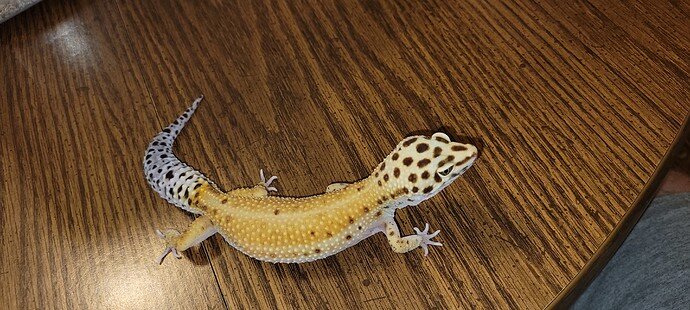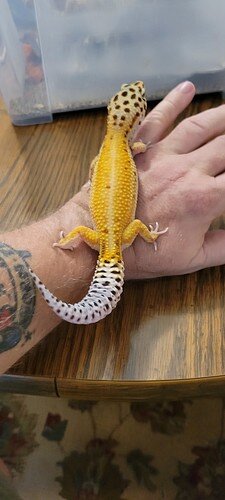Ok. So we aren’t breeding experts in our home…yet. But I want to be. So, the wife and I were talking and noticed that our adult female leo hasn’t laid any dud eggs. Are they supposed to lay dud eggs?
Here she is by the way.
We were told she is a g project red stripe.
4 Likes
I’m no expert on Leo’s, but hopefully these guys can help. @erie-herps @mblaney
1 Like
I assume you mean to ask whether it is abnormal for a female that has not been bred in a given season to lay slugs (dud eggs)?
If so- no worries! There’ nothing wrong with an adult female leo (that has not been bred) refraining from laying slugs. It would be very abnormal to have an un-bred female laying more than a few slugs in a season, she should not be producing the same numbers of eggs as a fertilized laying female.
She’s adorable! I really like how defined the spots on her head are and the sunny color of her body.
The G-Project is a bloodline (I’m pretty sure originating with Sasobek Reptiles- somebody correct me if I’m wrong) & not a description of appearance, so the only way you have of knowing whether she is a 100% pure G-Project gecko is based on the integrity of the seller.
She does not have a ‘Red Stripe,’ as that would be a very defined, bright orange pair of stripes on her back and down all the way through to the tip of her tail, whereas she is a Super Hypo (very few spots on her body). However, phenotypically, she has something that I’ve heard called a ‘Patternless Stripe,’ where the background hues of her body form 2 vague, thick stripes on her back, but her tail is not involved. I would personally describe her phenotype as a Super Hypo High Yellow, though some might say Super Hypo Tangerine. The crazy thing is that the correct morph description changes over the course of an animal’s lifetime, especially in their first 2-3 years.
It is a common mistake for newer breeders to just use the morph labels of the dam or sire to describe offspring they are trying to sell if they don’t know what they’re doing. So whoever sold her to you probably randomly bred a G-Project gecko with a Red-Stripe & sold her as both when she is definitely not a Red Stripe (specific appearance) and probably not 100% G-Project (specific bloodline). Unless you can nail down the exact genetics of your female, any of her offspring should be kept or sold/given away as Pet-Only.
5 Likes
@mblaney many thanks for the response! If we do breed her, her babies would definitely be given away as pet only. Or more than likely kept because my wife loves Leo’s so much!
It’s interesting that when we first got her, she has zero spots on her body. She only started getting them here recently. Seems to have a few more after each shed.
3 Likes
Well, I just noticed this thread so I’ll toss in my thoughts.
If she wasn’t bred then it’s okay that she doesn’t lay eggs. She could lay a slug clutch but don’t worry if she doesn’t.
As far as morph I think she could be a G-Project Red stripe. The dark areas on the upper lateral make me think Red stripe and the patterns of the head and tail make me think G-Stripe. And I thought Super Hypo was no spots, that would make this gecko a Hypo. However I’m not experienced with G-Stripe or Red stripe so I’ll defer to @mblaney for morph ID.
3 Likes
One thing folks haven’t mentioned here is that it’s really easy to check if your female has eggs too. Gently hold her in your hand and lift her back (or front) end until you can see the belly. If she has pink spots those are undeveloped eggs called follicles. When she ovulates and those follicles pass through the shelling organ, the eggs position themselves as bright white unmistakable eggs on either side of her midline near her hind limbs. There is an area of fat in that region too, which is more pinkish, so don’t mistake the fatty deposit with eggs; the eggs will be impossible to miss.
It’s also normal for females to have various stages of follicles and mature eggs in their bellies, especially when they’re in the full swing of breeding. They can lay multiple clutches a year, often one right after the other as soon as the next batch of eggs develops.
Females can also absorb the pink follicles and never drop them into the shelling organ to produce eggs. This happens most often with unmated females.
In short, it’s easy to check for eggs, it’s normal for unmated females to produce follicles but not always eggs, and if an unmated female does lay an egg or two it’s generally a non-issue.
7 Likes


